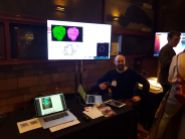Following on from the release of Panoptes Client 1.0 for Python, we’ve just released version 1.0 of the Panoptes CLI. This is a command-line client for managing your projects, because some things are just easier in a terminal! The CLI lets you do common project management tasks, such as activating workflows, linking subject sets, downloading data exports, and uploading subjects. Let’s jump in with a few examples.
First, downloading a classification export (obviously you’d insert your own project ID and a filename of your choice):
panoptes project download 764 Downloads/pulsar-hunters-classifications.csv

This command will optionally generate a new export and wait for it to be ready before downloading. No more waiting for the notification email!
New subjects can be uploaded to a new subject set like so (again, inserting your own IDs):
panoptes subject-set create 7 "November 2017 subjects" panoptes subject-set upload-subjects 16401 manifest.csv

You can also pipe the output from the CLI into other standard commands to do more powerful things, such as linking every subject set in your project to a workflow using the xargs command (where 1234 and 5678 are your project ID and workflow ID respectively):
panoptes subject-set ls -q -p 1234 | xargs panoptes workflow add-suject-sets 5678







